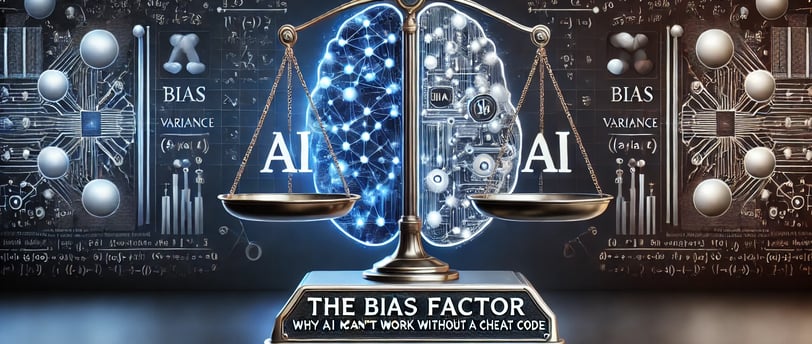Why Machine Learning?
The other day, during a family get-together, a few of my father’s retired friends asked me, "Why do we even need Machine Learning when we already have programming systems"
ARTIFICIAL INTELLIGENCEARTIFICIAL GENERAL INTELLIGENCEAI AUTOMATIONMACHINE LEARNING
Suman K
10/14/20223 min read


The other day, during a family get-together, a few of my father’s retired friends asked me, "Why do we even need Machine Learning when we already have programming systems".
This got me thinking. In my interactions with senior executives at large organizations, I often come across the same kind of confusion. They have a solid understanding of AI, but when it comes to explaining why AI or Machine Learning (ML) is necessary for problem-solving (instead of sticking with traditional programming methods), they struggle.
Even experienced Machine Learning (ML) professionals sometimes face the challenge of clearly articulating the need for AI/ML in solving complex problems, especially when compared to traditional rule-based systems. It’s one thing to implement a solution, but it’s another to convincingly explain why AI/ML is the best choice for that particular problem.
Thanks for reading Suman’s Substack! Subscribe for free to receive new posts and support my work.
Subscribed
I always tell them—you need AI when it’s the right tool for the problem at hand. AI is not a magic wand; it's useful when it helps solve a specific challenge more effectively than other methods.
I decided to share some of my thoughts on why ML/DL is important and how we can explain it in a simple way to those who aren’t deeply technical.
The Basics: What Is Machine Learning?
At its core, Machine learning can be understood like this:
A machine with Experience (E), doing Task (T) with a Performance (P)—where performance P improves with experience E.
They don’t need to be explicitly programmed for every task; they learn from the past and keep improving:)
When automating a problem to a solution we can take two approaches.
1️⃣ The Rule-Based Approach (Old School):
This method involves writing out explicit rules for every situation. For example, “If A happens, do B.” It works for simpler problems, but as complexity grows, it becomes unmanageable. The number of rules and combinations increases exponentially, and soon we’re dealing with millions of possibilities.
With 2 rules, you might face 3 failure points.
With 10 rules, you’re suddenly managing 1,023 combinations.
For 100 rules, you’d be dealing with billions of possibilities!
where for n rules, there are 2n−12^n - 12n−1 subsets of interactions. This is what’s called the complexity ceiling—a point where managing rules manually becomes impossible. How will a program handle billon if else statements. And just imagine just one change would change the whole architecture.
2️⃣The Connectionist Approach: intelligence doesn’t come from a set of hard-coded rules, but from the structure of the system itself.
Dumb Nodes, Smart Results:
Rather than relying on “smart” rules, connectionist approach uses simple nodes that, when connected correctly, learn to recognize patterns and make decisions on their own.
When the network makes the correct prediction, the connections between nodes are strengthened.
When it makes the wrong prediction, the connections are weakened.
With enough rounds of feedback, the system gets better at making the right predictions. It’s like learning from experience—the more data it gets, the smarter it becomes.
Solving Without Understanding:
DL doesn’t “understand” the problems it’s solving—it just solves them. This is the black box problem, where we can’t always explain how the network arrives at its answers, but it works.
So, how does the neural network actually learn? Through training data. This data serves as the “teacher,” guiding the system by showing examples of what’s right and what’s wrong. Initially, the neural network is clueless, but as it’s exposed to more examples, it starts adjusting its internal connections giving more weight to connections with correct and reduce weight to connection having wrong answers. Finally adjusting to a model where it can predict answers to new data as well.
The network adjusts its internal connections based on millions of parameters. Every time it gets new training data; it tweaks its internal workings. It’s like a student taking multiple practice tests—they start to see patterns, adjust their strategies, and get better over time.
The key here is feedback. With every correct and wrong answer, the network keeps adjusting, becoming smarter and more accurate. It’s a process that’s repeated over and over again until the system is able to make highly accurate predictions.
Training data is the key ingredient that makes all of this happen—it’s what guides the neural network through its learning process. Without it, the network wouldn’t know what’s right or wrong. The more data it’s given, the better it gets.
I’ve shared this explanation based on a mix of what I’ve read and understood about AI. As I’m still learning myself, I’m excited to share what I pick up along the way. If you’re curious about something specific, feel free to drop a comment—I’d love to discuss it further!
Location
Bengaluru . Helsinki
#663, OMBR Layout,560043
solution at pridct.com
